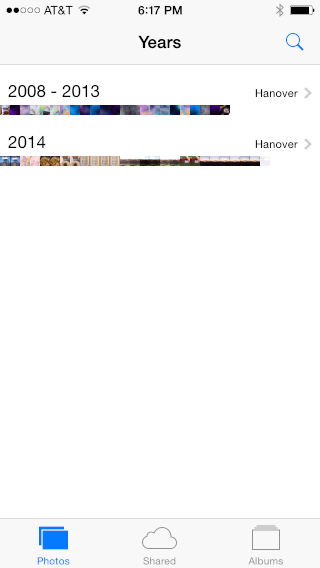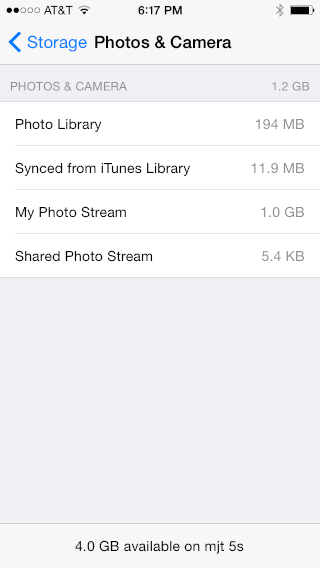iOS 8 Photo Stream Confusion
I previously noted that iOS 8 removed the Camera Roll. The files from the camera are still stored on the iPhone, but they now appear under Recently Added.
Recently, I’ve found that the situation is even more confusing than I had thought. I used Image Capture on the Mac to delete lots of photos from my “camera roll” and free up space. With iOS 7, these photos would have been in both the Camera Roll and Photo Stream. The Image Capture clean-out would have removed the duplicate copies, and I would still be able to see my recent photos via Photo Stream in the Photos app.
With iOS 8, I am instead seeing behavior that makes no sense. The photos are still in Photo Stream, as verified in Aperture, but they are no longer visible on the phone. This is the All Photos view in the Photos app:

There is no more Photo Stream section of the Photos app, but I had expected to see the Photo Stream photos mixed into the above view. Indeed, Apple says:
In iOS 8, there’s no longer a separate My Photo Stream album. Instead, photos that were in the My Photo Stream album are now in the Recently Added album.
But that’s not what happens. In the Photos view, I see just a small number of recent photos (not cleared out with Image Capture) and some photos synced from iTunes. The Recently Added album only shows the former.
Even more confusing, the Settings app shows that Photo Stream is using 1.0 GB of space for photos that it won’t show me:

Hopefully this is just a temporary hiccup until iCloud Photo Library is ready. The thing is, I don’t want Apple to store all my photos, and I don’t want to devote 1.0 GB of space on my iPhone to recent photos. All I want is to have new photos taken on the iPhone automatically transfer to my Mac without having to plug it in or manually initiate an import.
2 Comments RSS · Twitter
"Hopefully this is just a temporary hiccup until iCloud Photo Library is ready."
Even if your hopes are proven out, given Apple's stellar track record with online services, temporary may have an elongated meaning here, no?
I have similar frustrations with Apple's other cloud service, iTunes Match. In both cases I get the impression that Apple have failed to appreciate the constraints of the device/network. By doing so they've created system that are superficially simple, but are riddled with complexity if you veer off their idealised use case.
Of course, one could argue that Apple are looking to future and these constraints will soon be irrelevant. But I don't buy that. Apple are still selling devices with a poxy 8GB and 3G/4G connection limitation (speed and usage caps) have been an issue since this services launched (iTunes Match was launched 3 years ago in Nov '11) and I imagine will continue to be so for at least a few years.